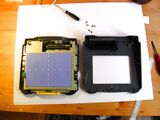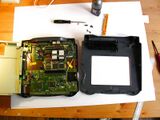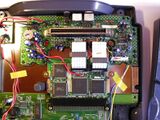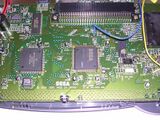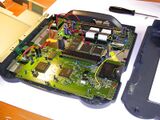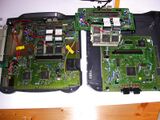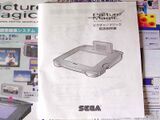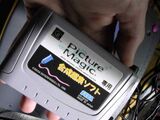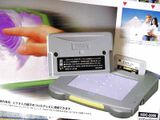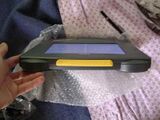Difference between revisions of "Picture Magic"
From Sega Retro
Scarred Sun (talk | contribs) (New page: frameless|right The '''Sega Picture Magic''' is a graphic tablet released in 1996 in Japan designed for use with the Sega Digio SJ-1 and the [[Sega Pri...) |
Scarred Sun (talk | contribs) m (Text replacement - "Harwdware" to "Hardware") |
||
| (16 intermediate revisions by 5 users not shown) | |||
| Line 1: | Line 1: | ||
| − | + | {{ConsoleBob | |
| − | The ''' | + | | logos= |
| + | | consoleimage=Picturemagic_pack3.jpg | ||
| + | | name= | ||
| + | | maker=[[Sega]] | ||
| + | | internal_games= | ||
| + | | releases={{releasesMisc | ||
| + | | misc_date_jp=1996 | ||
| + | }} | ||
| + | }} | ||
| + | The '''{{PAGENAME}}''' (ピクチャーマジック) is a graphic tablet released in 1996 in Japan designed for use with the [[Sega Digio SJ-1]] and the [[Sega PriFun]]. The Picture Magic can be used to overdraw, squeeze, reshape, and/or enhance photos taken off the SmartMedia Card. | ||
| − | + | ==Hardware== | |
| − | + | ||
| − | + | The Picture Magic comes with one plastic pen and one cartridge containing the software. Using the pencil and the yellow front button, you can easily interface with the software. The system seems to work with 2 layers (256*224 pixels 15bit true colors each), with one layer for the current drawing and one layer for the temporary work (resizing, stamping, layering...) For example, you can select one part of the picture and copy it, move it, resize it, or draw on it while keeping the original picture under. | |
| − | |||
| − | |||
| − | |||
| − | |||
| − | |||
| − | + | The output is A/V (composite) and the tablet is 22 x 18 cm. The system is based on the [[Sega 32X]] hardware (in fact many surplus [[Sega 32X]] hardware was recycled for use in the Picture Magic. It accepts 5V SmartMedia cards. | |
| − | The | ||
| − | Available tools | + | ===Available tools=== |
| + | {{multicol| | ||
*Load/save/Browse | *Load/save/Browse | ||
*Cut | *Cut | ||
| Line 46: | Line 50: | ||
*Color Finder pencil | *Color Finder pencil | ||
*Undo | *Undo | ||
| + | |cols=3}} | ||
| − | ==Internals== | + | ===Internals=== |
The PMagic uses an standard [[32X]] board without any modification. This board is plugged into a pseudo-[[Mega Drive]] motherboard, as unlike the Mega Drive console: | The PMagic uses an standard [[32X]] board without any modification. This board is plugged into a pseudo-[[Mega Drive]] motherboard, as unlike the Mega Drive console: | ||
*It lacks FM/PSG/sound hardware | *It lacks FM/PSG/sound hardware | ||
*Has a smaller I/O Bus Controller chip than the classic Mega Drive II | *Has a smaller I/O Bus Controller chip than the classic Mega Drive II | ||
| − | *Is | + | *Is physically smaller |
*Has only one input button | *Has only one input button | ||
*Contains one SmartMedia connector directly on the PCB | *Contains one SmartMedia connector directly on the PCB | ||
| Line 57: | Line 62: | ||
*Has two wires (Composite Sync and SC) that goes to the 32X Video IN. | *Has two wires (Composite Sync and SC) that goes to the 32X Video IN. | ||
| − | The Picture Magic cartridge contains a 512KB ROM that looks like a standard 32X ROM. However, there are a few differences. The ROM header is standard 32X, though there is another header called "JANUS INITIAL PROGRAM" (JANUS = code name of the Digio). Another odd thing is that nothing starts up the 32x; it starts by itself. There is a high probability that the 32X | + | The Picture Magic cartridge contains a 512KB ROM that looks like a standard 32X ROM. However, there are a few differences. The ROM header is standard 32X, though there is another header called "JANUS INITIAL PROGRAM" (JANUS = code name of the Digio). Another odd thing is that nothing starts up the 32x; it starts by itself. There is a high probability that the 32X BIOS is different from the commercial 32X one. When opening the cart, one can see two jumpers points on the PCB, with one soldered. In the actual jumper configuration, the whole cart is 16-bit, like commercial 32X carts. Editing those jumpers puts the lower part of the cart in 16-bit mode and the upper part in 8-bit mode. |
| − | These jumpers were added in case the board was Z80-based, for cost reasons, but Sega finally chose to go with a 68000 board. This is possibly due to the commercial failure of the 32X and the extra stock Sega would have likely had on hand. This also explains why the 32X starts up by itself—an 8-bit | + | These jumpers were added in case the board was Z80-based, for cost reasons, but Sega finally chose to go with a 68000 board. This is possibly due to the commercial failure of the 32X and the extra stock Sega would have likely had on hand. This also explains why the 32X starts up by itself—an 8-bit CPU cannot start up the 32X. So, to conclude, the CPU choice was made at last minute with a rushy design. |
| − | <gallery widths="200 | + | <gallery widths="200"> |
Image:picturemagic_hard0.jpg | Image:picturemagic_hard0.jpg | ||
Image:picturemagic_hard1.jpg | Image:picturemagic_hard1.jpg | ||
| Line 69: | Line 74: | ||
Image:picturemagic_hard5.jpg | Image:picturemagic_hard5.jpg | ||
</gallery> | </gallery> | ||
| + | |||
| + | ==Gallery== | ||
| + | <gallery widths="200"> | ||
| + | Image:picturemagic_pack0.jpg | ||
| + | Image:picturemagic_pack1.jpg | ||
| + | Image:picturemagic_pack2.jpg | ||
| + | Image:picturemagic_pack4.jpg | ||
| + | Image:picturemagic_pack5.jpg | ||
| + | </gallery> | ||
| + | |||
| + | ==Physical scans== | ||
| + | {{Scanbox | ||
| + | | console=Digio | ||
| + | | region=JP | ||
| + | | front=picturemagic_packfull.jpg | ||
| + | | back= | ||
| + | }} | ||
| + | |||
| + | ==References== | ||
| + | <references /> | ||
[[Category:Hardware]] | [[Category:Hardware]] | ||
| − | [[Category: | + | [[Category:Consumer products]] |
Latest revision as of 22:42, 19 July 2019
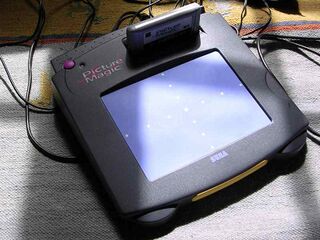
| |||||||||
| Picture Magic | |||||||||
|---|---|---|---|---|---|---|---|---|---|
| Manufacturer: Sega | |||||||||
|
The Picture Magic (ピクチャーマジック) is a graphic tablet released in 1996 in Japan designed for use with the Sega Digio SJ-1 and the Sega PriFun. The Picture Magic can be used to overdraw, squeeze, reshape, and/or enhance photos taken off the SmartMedia Card.
Hardware
The Picture Magic comes with one plastic pen and one cartridge containing the software. Using the pencil and the yellow front button, you can easily interface with the software. The system seems to work with 2 layers (256*224 pixels 15bit true colors each), with one layer for the current drawing and one layer for the temporary work (resizing, stamping, layering...) For example, you can select one part of the picture and copy it, move it, resize it, or draw on it while keeping the original picture under.
The output is A/V (composite) and the tablet is 22 x 18 cm. The system is based on the Sega 32X hardware (in fact many surplus Sega 32X hardware was recycled for use in the Picture Magic. It accepts 5V SmartMedia cards.
Available tools
- Load/save/Browse
- Cut
- Stamp Off
- Stamp ON
- Stamp with half transparency
- Erase
- Effects
- Gradients
- Linear (various angles)
- Radial
- Pixelize
- Sepia
- Black and White
- Invert Colors
- Gradients
- Drawing
- Circle/Ellipse
- Line
- Finger (magic finger)
- Pens
- Little/Medium/Big pencil
- Little/Medium/Big progressive transparency pencil
- Little/Medium paint effect
- Color fill
- Low/Medium/Hi/Full color filling
- Spray
- Typing in Japanese/Numbers/Letters/Symbol
- Full Screen Preview
- Color Selector
- Select
- Color Finder pencil
- Undo
Internals
The PMagic uses an standard 32X board without any modification. This board is plugged into a pseudo-Mega Drive motherboard, as unlike the Mega Drive console:
- It lacks FM/PSG/sound hardware
- Has a smaller I/O Bus Controller chip than the classic Mega Drive II
- Is physically smaller
- Has only one input button
- Contains one SmartMedia connector directly on the PCB
- Has a graphic tablet jack hooked on two ADC (one for X coordinates and the other for Y).
- Has two wires (Composite Sync and SC) that goes to the 32X Video IN.
The Picture Magic cartridge contains a 512KB ROM that looks like a standard 32X ROM. However, there are a few differences. The ROM header is standard 32X, though there is another header called "JANUS INITIAL PROGRAM" (JANUS = code name of the Digio). Another odd thing is that nothing starts up the 32x; it starts by itself. There is a high probability that the 32X BIOS is different from the commercial 32X one. When opening the cart, one can see two jumpers points on the PCB, with one soldered. In the actual jumper configuration, the whole cart is 16-bit, like commercial 32X carts. Editing those jumpers puts the lower part of the cart in 16-bit mode and the upper part in 8-bit mode.
These jumpers were added in case the board was Z80-based, for cost reasons, but Sega finally chose to go with a 68000 board. This is possibly due to the commercial failure of the 32X and the extra stock Sega would have likely had on hand. This also explains why the 32X starts up by itself—an 8-bit CPU cannot start up the 32X. So, to conclude, the CPU choice was made at last minute with a rushy design.
